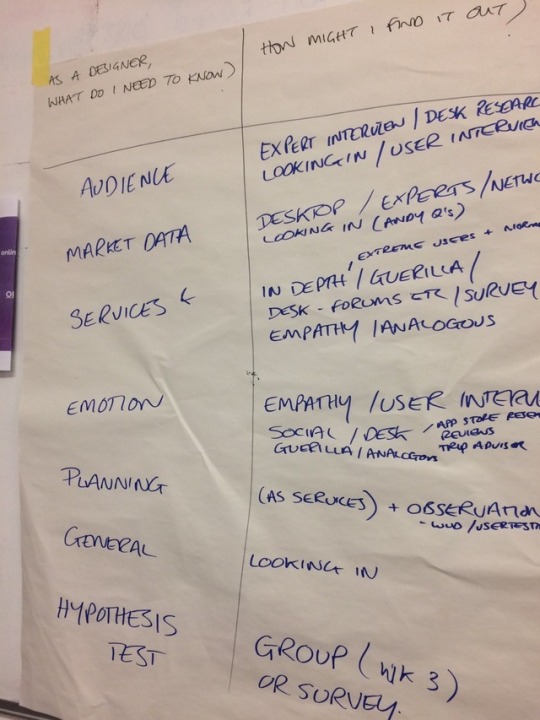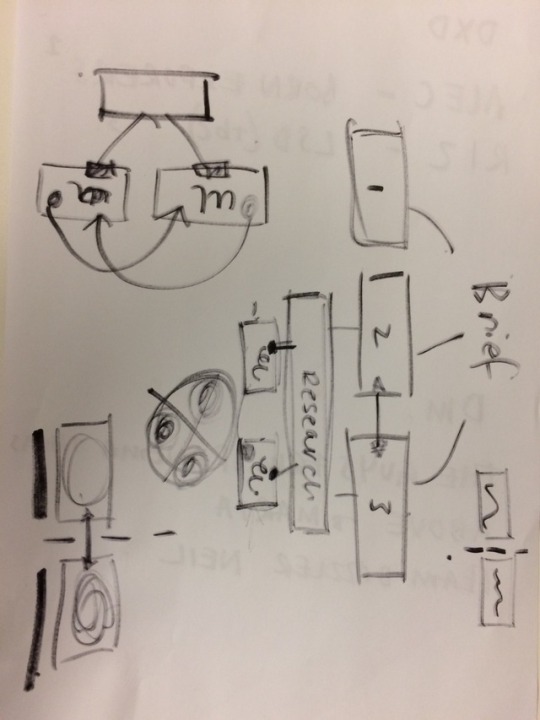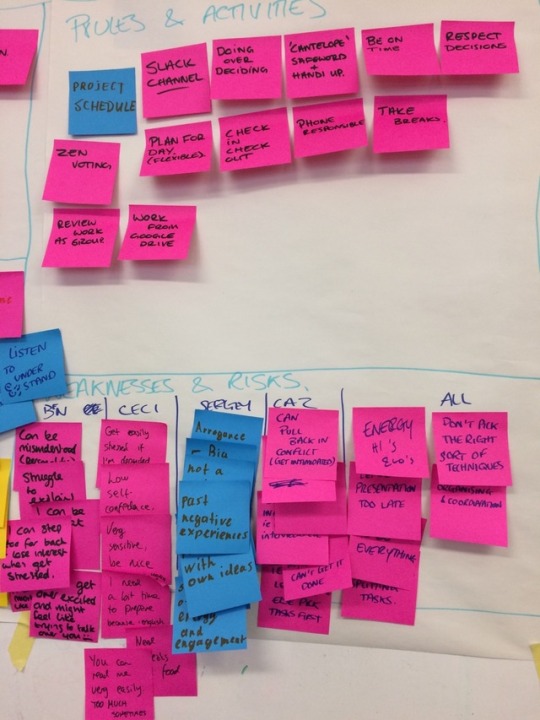A compilation of work, ideas of thoughts while studying for my Masters degree at Hyper Island. Design Thinking
Don't wanna be here? Send us removal request.
Photo



Research // We ended yesterday by deciding on how we would begin researching for our understanding people brief. We started by asking what we needed to know and then looking at these questions we decided on which research methods would work best to answer the questions. We also decided on a way for the teams to work together so as not to overlap on research and find out information in the most effective way so we could share insights with each other and in turn strengthen our opportunity areas.
2 notes
·
View notes
Photo



Team development // Yesterday we started by developing our teams culture. We used the team canvas method to gather various insights about our team members and then translate these into rules and values to help us understand each other and work more effectively. The above images show how we gathered this information. It is a great way to start a team it helps to work together if we know each other's strong and weak points and offers us a tool to work around these as well as showing how we cross over skills wise or balance each other's weeknesses out.
0 notes
Photo

As part of Cate and Lydia's talk yesterday we were asked to go out and research in the form of observation this is also a form of guerrilla research. In relation to the brief we went to a coach station as a team to do some in depth observations. Some of us sat and watched while others interviewed staff, we found a sense of insecurity for the people using the service which we found was due to a confusion on where to find information as well as a surprising reliance on people over technology, for example one woman could see she might of nearly missed her bus but still asked a member of staff.
0 notes
Photo


Understanding People //
Yesterday we were introduced to our new brief which is based roughly on a human centred approach to research. Cate and Lydia, both ex IDEO now successful freelance introduced the brief and themselves as our coaches they also gave us a presentation on human centred design research, ran an observation workshop and led an interview with our client for our new brief.
The presentation was extremely useful and interesting they explained the human centred approach and it’s methodology through use of case studies. Two methods I found most interesting and am eager to try for this brief are Analogous research and Empathy building.
Analogous research is the transfer of ideas from one situation to a parallel one in order to gain insights from the parallel situation. This can work in a few ways, for example Lydia explained how IDEO used the idea of NAZ car racing pit stop and transferred this into ER, these situations might seem very far from each other however both are high stress situation with a need for speed and precision and so there were many transferable elements such as a doctor that was there only to direct the other nurses and doctors in the same way a mechanic directs other mechanics. It also works in an interview sense, another example was given around cancer diagnosis the patients are dealing with a word that people might not like to here and has stigma attached so speaking to someone who has recently come out gay in a very straight environment can give insights. A third way is finding experiences that have transferable elements, Cate spoke of a case study were people didn’t visit care homes because they didn’t know how to act there so she took the staff to an eat in the dark event, in the same way that the patients relative had no idea how to act at the homes, the staff had no idea how to do basic things, like go to the toilet at the event which caused them to empathise with the relatives and helped Cate to gain insights into possible pain points. Analogous research can help you to isolate elements of an experience and apply them to what your working on.
Building empathy is the idea of putting yourself in the users experience. For example Lydia spoke of how she would go on meet and greets for a hotel company in the same way the staff would, this helped her to see the experience from a different perspective and hopefully gain insights that might have gone unnoticed such as the way the staffs uniform appears to a customer or when cleaning she realised that the staff which mainly had English as a second language were forced to rely on a very text heavy app. This idea works best if you bring people of different disciplines as their brains work in different ways and notice different things in an experience for example a graphic designer might see the lay out of a room where as a manager might see how staff interact.
Brief //
We also got a chance to speak to our client, this was a chance for research in the form of ‘looking in’. The brief is to find opportunity areas for Late Rooms to move into trips. We have been given the focus of before people go on the trip. Apart from asking the client questions and some planning we haven’t started working on the brief yet or started team development so I will post more about this once we begin.
0 notes
Photo


After the weekend we each presented ideas we had developed over the weekend to each other ready to chose our ideas to talk about with Leena and Sean. We noticed that three strong themes occurred; awareness, environment and coping mechanisms and decided to present them without killing darlings, as the team was reluctant to do this, but by dot voting for our favourite and using these as the main ideas to present and then presenting any of our other ideas if these came up in conversation or it felt the right time.
This worked in our favour and we got some great feedback that has shaped our many ideas into one strong idea for us to develop further. One thing to note is that one of the ideas brought up in conversation was the persons favourite (darling) and although it worked in our favour to bring it up in conversation they were kind of blindsided by how much they liked the idea and started to dismiss the other strong ideas that Leena and Sean said to develop along with it. Ignoring any client feedback can be dangerous and meant that one team member suggested that idea was most important and the others where secondary when in fact the other team members felt they worked in sync with each other and one made the other idea stronger.
It’s as though the excitement of getting good feedback on a single idea blinded them to the full picture and in my opinion would of ended with an solution that wasn’t as strong, made us miss important details that we already had in the other ideas that the client was expecting to see. Even when your darlings work it’s important to take a step back and be open to other ideas as these can build on your own and make it stronger.
0 notes
Photo







On the Thursday before Steve's talk we had began ideation. We used some simple games to get us started and built on them to refine our ideas. We found word association most helpful and but also tried flip reverse without much effect. I think the reason word association worked so well is down to the personality of our team. We are very open to new ideas and give each idea a deserved amount of thought before moving onto the next. Random word association gave us time to be free with our thinking with no need to kill darlings, which I am aware some of the team are quite anxious about doing. We also tried scamper which again worked quite well but mostly highlighted problems we already knew as did flip reverse. Still we got some great ideas from scamper. We ended up with a few large flip charts of ideas and half ideas and grouped them into clusters to help develop the ideas further. This gave us chance to get familiar with and discuss the ideas. After some disagreement on where to place ideas we ended up with seven clusters that we then left to think on over the weekend.
0 notes
Photo




Some of the slides from Steve's presentation.
0 notes
Photo










On Friday we were introduced to Steve Rawling. He is a journalist who specialises in storytelling and pitching. He showed us some models for creating stories that we could use to create more interesting pitches when we present our ideas to the BBC. The talk was immensely helpful and included workshops that we used to create a user journey that could help us in our presentations. We used the story arch framework and applied this to our user journey along with the idea of mentors which are styles of narrative that tell the story in a certain way, for example the Muse inspires your hero (user) to express themselves.
0 notes
Photo







After speaking with a few people who sounded interested in helping us with some primary research and journey mapping we unfortunately couldn't arrange anything within our schedule. Instead we used our personas that we had created using interviews and other research to go on a journey ourselves and empathise with how a neurodivergent person might feel. We used Andy's template and hacked it slightly to suit our needs. It really helped us to build up a picture of how they might feel at an event or gig and we finished with two journey maps that we used to highlight pain points and touch points to help ideation.
0 notes
Photo

TEAM DEVELOPMENT // I feel it is important to say a little about how the team is getting on so far as well as our progress in the brief. The team has certainly had a few ups and downs, we are still learning each other's needs and how each other work best. Saying this how ever there is a mutual respect for each other. I believe the respect and culture we have formed is mostly down to the team development stage before the brief and reflection but is also slowly evolving with us as the team moves through different areas of the project. I believe our team will only grow stronger as we move through the brief which isn't to say we won't encounter some conflict along the way. It is an important part of the process to make sure we develop a healthy team attitude and support each other.
0 notes
Photo





For the past two days my team have been working hard on the BBC and CAPe Neurodiversity brief. We have gotten off to a great start, first dicepting the brief to gain a greater and more in depth idea of what it is actually asking if us and have gathered research from both primary and secondary sources. For primary research we approached charities and organisations that are involved in neurodiversity and also approached individuals, both being neurodivergent themselves or being connected with them. We have interviewed four individuals so far; a psychologist, a father of a neurodivergent child, an autistic poet and a YouTuber who is also on the neurodiverse spectrum. Thanks to our research we have managed to build four personas that we can use to emphasise a customer journey. It would of been a lot nicer if we could of gone on a customer journey with someone who is on the spectrum but at the moment this hasn't been an option for us.
0 notes
Photo









TEAM DEVELOPMENT // Before we got stuck into the BBC brief we was advised by Tash to complete some team development exercises. We started with reflection and feedback which was extremely helpful in moving our team forward. We all got a lot off our chest and with each of us being open and honest we managed to work through a lot of issues and understand each other a lot better than we had done in the previous week. Any misgivings where heard and sorted through together as well as any plus points we should stick to and I at least felt we grew as a group. This became evident when we used the 'Team Canvas exercise to go over some ground rules and general ideas of how our team would work best together (shown above)
0 notes
Photo


BBC NEURODIVERSITY BRIEF // Yesterday we where briefed on a new group project. The brief was set by the BBC and presented to us by the senior designer of CAPE who is neurodiverse herself and Sean from the BBC. The main challenge of the brief is to lock on to the challenge of a neurodiverse person going to a gig in Manchester, taking into account the challenges they might face and what are the solutions to the circumvent issues. Each team will be given a trait of the neurodiverse to concentrate on, my team being assigned sensory/shock/overload. The presentation on neurodiversity offered a great insight into the world of the people effected by cognitive issues that may not be immediately noticeable to other people and included a VR day in the life of a neurodiverse person in the work place. A main couple of interesting points I took away where the difference in medical and social definitions and ways of supporting neurodiverse people and also the idea that although they encounter many challenges they bring lots of benefits with them, whether that be a new way of seeing the world or a specific quality or niche they work well in. I can't wait to get stuck into the brief in more depth with my team and see what ideas we can come up with!
0 notes
Photo


A couple of the other teams customer journey maps, we saw some great examples of how to map a customer journey with no two presentations the same, you could take or leave from all presentation when creating future customer journey maps.
0 notes
Photo



POLETASTIC // I mentioned in my last post that we would be presenting our customer journey map for our pole dancing experience. Above is an image of the map we created together as a team, we used the idea of the pole to illustrate time and picked out relevant emotions and touch points to talk about to Gill And the rest of the class. We also used lines as a graph to illustrate whether our emotions where on the positive or negative side of the scale during any point of our experience. We gained some great feedback from Gill as well as our fellow Hypers that we could work. The main feedback from Gill being that if we had more time we could include reasoning behind what caused each emotion or high/low point. In terms of presenting I feel our story was slightly wishie washy and didn't have much structure however we wanted to try something a little different from the other teams and went for it. We also created a video to compliment the presentation and to some up our overall feelings.
0 notes
Photo




POLEDANCING // So after our two day brief we was briefed again, this time by another industry leader Gill Wildman. Gill wanted us to try something completely new as a team and then come back and create a visual journey through the experience that we could present to the rest of the team. It was important that we documented all aspects of the experience; before, during and after, picking up on what we saw, felt, thought and did. Using our skills as designers. Our team decided on pole dancing, a crazy choice but something not so out of my comfort zone that I wouldn't do it. I went along hesitantly but at the same time excited and nervous. The experience was actually fantastic and something I would do again, the teacher was brilliant and I think all of the team enjoyed it and all came away oozing confidence. Today is the day we present our journey which should be interesting considering it includes a very funny video I created of the experience!
0 notes
